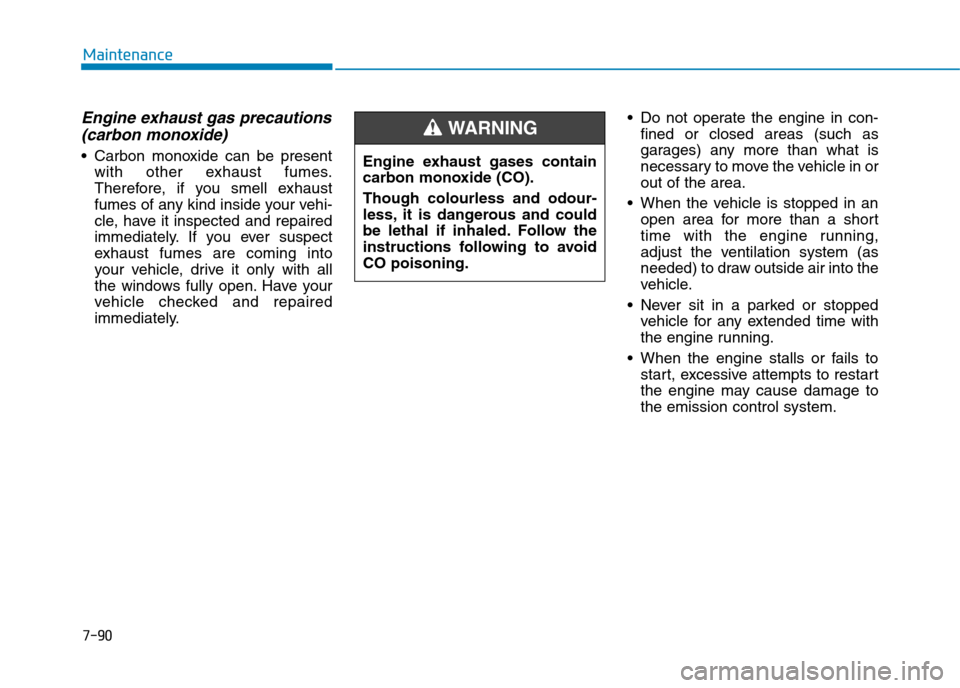Page 535 of 571
7-65
7
Maintenance
Fuse NameSymbolFuse ratingCircuit Protected
BATT140ASmart Junction Block (LEAK CURRENT AUTOCUT DEVICE, Fuse : F10, F12, F21, F29, F38)
DCT140ATCM
DCT240ATCM
B/ALARM HORN10ARLY.7
S/FUEL PUMP15ARLY.5
ABS140AABS Control Module, ESC Control Module, Multipurpose Check Connector
ABS230AABS Control Module, ESC Control Module, Multipurpose Check Connector
POWER40ARLY.14
Engine compartment main fuse panel
Page 536 of 571
7-66
Maintenance
Engine compartment main fuse panel - PCB Block (Nu 2.0 MPI)
Fuse NameSymbolFuse ratingCircuit Protected
SNSR210APurge Control Solenoid Valve, Variable Intake Solenoid Valve, E/R Junction Block (RLY.2, RLY.9), Cold Start Solenoid Valve
ECU215APCM
ECU110A-
INJ.15AINJECTOR #1~#4
SNSR115AOxygen Sensor (Up), Oxygen Sensor (Down)
IGN.15AIgnition Coil #1~#4, Condenser
SNSR320AFuel Pump Relay, Oil Control Valve #1, Oil Control Valve #2
HORN10AHorn Relay
ECU510APCM
SNSR420A-
ABS315AABS/ESC Control Module, Multipurpose Check Connector
TCU215AVe h i c l e S p e e d S e n s o r, Tr a n s m i s s i o n R a n g e S w i t c h , E / R J u n c t i o n B l o c k ( F u s e : F 1 7 )
ECU420APCM
ECU310APCM
F/PUMP20AFuel Pump Relay
Page 560 of 571

7-90
Maintenance
Engine exhaust gas precautions
(carbon monoxide)
•Carbon monoxide can be present
with other exhaust fumes.
Therefore, if you smell exhaust
fumes of any kind inside your vehi-
cle, have it inspected and repaired
immediately. If you ever suspect
exhaust fumes are coming into
your vehicle, drive it only with all
the windows fully open. Have your
vehicle checked and repaired
immediately.
•Do not operate the engine in con-
fined or closed areas (such as
garages) any more than what is
necessary to move the vehicle in or
out of the area.
•When the vehicle is stopped in an
open area for more than a short
time with the engine running,
adjust the ventilation system (as
needed) to draw outside air into the
vehicle.
•Never sit in a parked or stopped
vehicle for any extended time with
the engine running.
•When the engine stalls or fails to
start, excessive attempts to restart
the engine may cause damage to
the emission control system.
Engine exhaust gases contain
carbon monoxide (CO).
Though colourless and odour-
less, it is dangerous and could
be lethal if inhaled. Follow the
instructions following to avoid
CO poisoning.
WA R N I N G
Page 569 of 571

8-8
Specifications & Consumer information
Recommended SAE viscosity
number
Engine oil viscosity (thickness) has
an effect on fuel economy and cold
weather operating (engine start and
engine oil flowability). Lower viscosi-
ty engine oils can provide better fuel
economy and cold weather perform-
ance, however, higher viscosity
engine oils are required for satisfac-
tory lubrication in hot weather.
Using oils of any viscosity other than
those recommended could result in
engine damage.
When choosing an oil, consider the
range of temperature your vehicle
will be operated in before the next oil
change. Proceed to select the rec-
ommended oil viscosity from the
chart.
Always be sure to clean the area
around any filler plug, drain
plug, or dipstick before check-
ing or draining any lubricant.
This is especially important in
dusty or sandy areas and when
the vehicle is used on unpaved
roads. Cleaning the plug and
dipstick areas will prevent dirt
and grit from entering the
engine and other mechanisms
that could be damaged.
CAUTION
*1:For better fuel economy, it is recommended to use the engine oil of a viscosity grade SAE5W-20.
Te m p e r a t u r e R a n g e fo r S A E V i s c o s i t y N u m b e rs
Te m p e r a t u r e
Petrol Engine Oil
°C
(°F)
-30 -20 -10 0 10 20 30 40 50
-10 0 20 40 60 80 100 120
20W-50
15W-40
10W-30
5W-20*1,5W-30